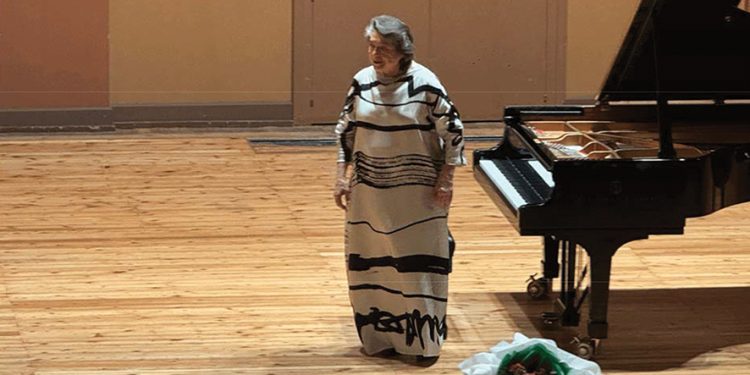Elisabeth Leonskaja’s recital at the Toradze Festival 2024 was a masterclass in Beethoven interpretation. Her rendition of Beethoven’s late sonatas not only honored the composer’s genius, but also offered a deeply personal and reflective interpretation that resonated with all who were fortunate enough to attend.
Beethoven’s music meets its final note
As one of the most revered pianists of her generation, Leonskaja’s approach to Beethoven is marked by a profound understanding of the composer’s intentions, an ability to convey the emotional depth of the works, and a meticulous attention to the structural and technical details. Her engagement with Beethoven’s music reflects a deep reverence for the composer’s vision, balancing fidelity to the score with a personal interpretive touch. Leonskaja’s interpretations are always valuable for their clarity, structural coherence, and dynamic range.
Intellectual Depth: Leonskaja approaches Beethoven’s music with a scholarly rigor, understanding the historical and theoretical contexts of the works. She delves into the intricacies of Beethoven’s compositional techniques, ensuring that her performances are informed by a comprehensive grasp of the music’s underlying structures.
Emotional Resonance: Despite her analytical approach, Leonskaja never loses sight of the emotional core of Beethoven’s music. Her performances are imbued with a sense of passion and intensity that brings the composer’s emotional landscape to life. She has the rare ability to convey the full spectrum of human experience, from the depths of despair to the heights of joy.
Technical Mastery: Leonskaja’s technical prowess is evident in her command over the piano. She possesses a remarkable control over dynamics, phrasing, and articulation, allowing her to navigate the technical challenges of Beethoven’s works with ease.
Sonata No. 30 in E Major, Op. 109
Leonskaja’s interpretation of Op. 109 highlights the lyrical and contrasting elements of the sonata. The first movement, Vivace ma non troppo – Adagio espressivo, is approached with a delicate touch, emphasizing the song-like quality of the themes. Leonskaja’s sensitivity to the shifts between vivacious and contemplative passages showcases her ability to navigate Beethoven’s nuanced emotional landscape.
In the second movement, Prestissimo, Leonskaja demonstrates her technical agility and precision. Her playing is marked by a crisp articulation and a driving energy that captures the movement’s urgency. The final movement, Gesangvoll, mit innigster Empfindung, is rendered with a profound sense of introspection and serenity. Leonskaja’s ability to sustain a lyrical line and maintain a sense of continuity through the variations is particularly noteworthy.
Sonata No. 31 in A-flat Major, Op. 110
Op. 110 is a work of deep emotional and structural complexity, and Leonskaja’s interpretation brings out its multifaceted character. The opening movement, Moderato cantabile molto espressivo, is played with a warm, singing tone that emphasizes the lyrical nature of the music. Leonskaja’s phrasing is expressive, bringing out the vocal qualities inherent in Beethoven’s writing.
The second movement, Allegro molto, showcases her rhythmic precision and dynamic contrasts. Leonskaja’s ability to convey the playful, almost scherzo-like character of the movement adds a layer of charm to the performance. The final movement, Adagio ma non troppo – Fuga: Allegro ma non troppo, is a testament to her interpretive depth. The fugue, with its intricate counterpoint and emotional intensity, is rendered with clarity and coherence, highlighting Leonskaja’s intellectual engagement with the music.
Sonata No. 32 in C Minor, Op. 111
Leonskaja’s performance of Op. 111 is marked by its dramatic intensity and spiritual depth. The first movement, Maestoso – Allegro con brio ed appassionato, is played with a powerful, commanding presence. Leonskaja captures the movement’s dramatic contrasts and rhythmic drive, bringing out the tension and resolution that characterize Beethoven’s late style.
The second and final movement, Arietta: Adagio molto semplice e cantabile, is where Leonskaja’s interpretive genius truly shines. Her playing is imbued with a sense of timelessness and transcendence, capturing the movement’s meditative and ethereal qualities. The variations unfold with a natural, organic flow, culminating in the serene and sublime final variation, which Leonskaja plays with a profound sense of inner peace and reflection.
Returning to bridge the path
Leonskaja’s return to Tbilisi is symbolic of the enduring connection between the artist and her roots. Despite her international acclaim, this performance is a testament to her bond with her homeland and her contribution to its cultural enrichment. It underscores the notion that classical music, while universal, is deeply personal and rooted in the identity of both the performer and the audience. This recital also serves as an inspiration for young musicians in Georgia, demonstrating the heights that can be achieved with dedication and passion. Leonskaja’s journey from Tbilisi to global stages embodies a narrative of artistic excellence that can motivate and encourage emerging talent.
By Ivan Nechaev














